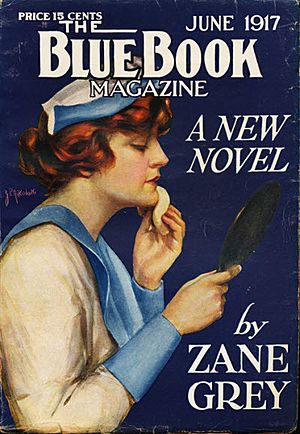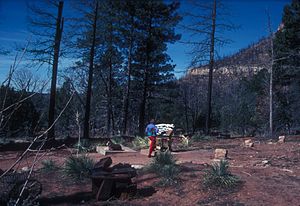Zane Grey facts for kids
Quick facts for kids
Zane Grey
|
|
|---|---|
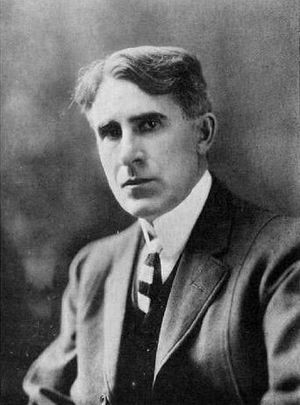 |
|
| Born | Pearl Zane Grey January 31, 1872 Zanesville, Ohio, United States |
| Died | October 23, 1939 (aged 67) Altadena, California, United States |
| Resting place | Lackawaxen and Union Cemetery, Lackawaxen, Pennsylvania |
| Occupation | Novelist, dentist |
| Nationality | American |
| Genre | Western fiction |
| Signature | |
Pearl Zane Grey (born January 31, 1872 – died October 23, 1939) was an American author and dentist. He is famous for his adventure novels and stories about the American West. He loved to write about the American frontier. His most popular book was Riders of the Purple Sage (1912).
Many of his books were also made into movies and TV shows. Over 100 films and several TV episodes were based on his stories. One TV series was called Dick Powell's Zane Grey Theater.
Contents
Zane Grey's Life Story
His Early Years
Pearl Zane Grey was born on January 31, 1872, in Zanesville, Ohio. His mother's family, the Zanes, had been in America since 1673. His great-grandfather, Ebenezer Zane, was a hero in the American Revolutionary War. Zane Grey's father, Lewis M. Gray, was a dentist. The family later changed their last name to "Grey." Zane eventually dropped "Pearl" and used Zane as his first name.
Zane grew up in Zanesville, a city founded by his grandfather. He and his brother, Romer, were very active. They loved playing baseball and fishing. From a young age, Zane was interested in history. He soon started to enjoy writing too. These early interests helped him a lot in his later writing career. For example, his first three novels were about his ancestors who fought in the Revolutionary War.
As a child, Zane spent a lot of time with an old man named Muddy Miser. Muddy Miser liked Zane's love for fishing and writing. He also talked about living an unusual life. Even though Zane's father told him to stay away, Zane learned a lot from Muddy Miser.
Zane loved reading adventure stories like Robinson Crusoe. He also enjoyed Leatherstocking Tales and dime novels about characters like Buffalo Bill. He tried to copy the drawings of famous artists like Howard Pyle. A book called Our Western Border about the Ohio frontier really inspired him. Zane wrote his first story, Jim of the Cave, when he was fifteen.
In 1889, Zane's family moved to Columbus, Ohio, because his father had money problems. While his father tried to restart his dental practice, Zane helped by visiting homes and pulling teeth. He did this until the state stopped him. Zane also worked as an usher at a theater. In the summer, he played baseball for the Columbus Capitols. He dreamed of playing in the major leagues. Zane and his brother Romer were both good baseball players. Romer even played professionally.
College and Baseball
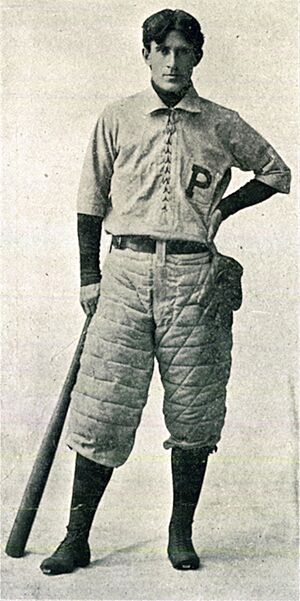
Zane Grey went to the University of Pennsylvania on a baseball scholarship. He studied dentistry there and joined the Sigma Nu fraternity. He graduated in 1896. When he first arrived, he had to prove he deserved the scholarship. He did this by pitching well in a game and hitting a double that helped his team win. The college baseball league was very competitive.
Zane was a strong hitter and a great pitcher. He had a special curve ball that dropped sharply. When the pitching distance changed in 1894, his pitching was not as good. So, he moved to the outfield. He was still a campus hero because of his important hits.
Zane was not a top student. He spent most of his time on baseball, swimming, and writing, especially poetry. He was a bit shy and didn't socialize much. He thought about becoming a writer or a baseball player. But he decided that dentistry was the more practical choice for his career.
After college, Zane played minor league baseball for several teams. His brother Romer Carl "Reddy" Grey also played professionally in the minor leagues. They even played together for the Findlay Sluggers in 1895. Romer played one major league game for the Pittsburgh Pirates in 1903.
Becoming a Dentist
After graduating, Zane Grey opened his dental practice in New York City in 1896. He wanted to be near publishers. He started writing in the evenings because his dental work was boring. He had money troubles and felt down sometimes. Zane was a natural writer, but his early stories were a bit stiff. Whenever he could, he played baseball with the Orange Athletic Club. This team was one of the best amateur teams in the country.
Zane often went camping with his brother R.C. in Lackawaxen, Pennsylvania. They loved to fish in the Delaware River. In 1900, Zane met Lina Roth, who was 17. Everyone called her "Dolly." Dolly was studying to be a schoolteacher.
Marriage and Family Life
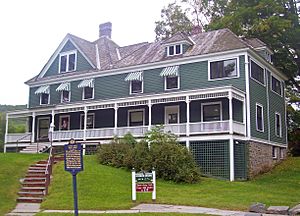
Zane and Dolly married in 1905 after five years of dating. Zane often felt sad or angry, which affected him throughout his life. He once wrote about these feelings, saying they were like a "black spell."
After they married, Dolly stopped teaching. They moved to a farmhouse in Lackawaxen, Pennsylvania. Zane's mother and sister also joined them. This house is now the Zane Grey Museum. Zane finally stopped being a dentist to focus on writing full-time. Dolly's family money helped them financially at first.
Dolly was very important to Zane's career. She managed his writing career and took care of their three children, including their son Romer Zane Grey. Zane often spent months away from his family. He really valued Dolly's help with his career and family. She was also a great editor for his books. She was good at business and handled all his deals with publishers and movie studios. They split all his earnings evenly. Dolly used her half to cover all the family's expenses.
In 1918, the Greys moved to California. In 1920, they settled in Altadena, California, in a home known as the "Zane Grey Estate." Zane loved Altadena, saying it had "qualities that make life worth living."
His Writing Career
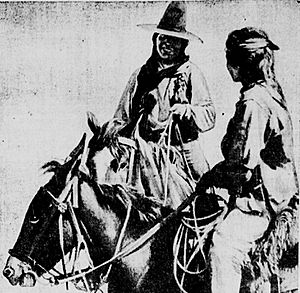
With Dolly's help, Zane Grey's writing got better. His first magazine article, "A Day on the Delaware," was published in 1902. It was about a fishing trip with his brother. Zane was so happy he sold the article that he gave copies to patients in his dental waiting room. Writing helped Zane escape from his problems. He said, "Realism is death to me. I cannot stand life as it is." By this time, he had stopped playing baseball.
Zane read a famous Western novel called The Virginian. He studied how it was written and decided to write his own long story. His first novel, Betty Zane (1903), was hard to write. A publisher rejected it, which made him very sad. The novel was about his brave ancestor who saved Fort Henry. He ended up publishing it himself. From the start, his writing was known for its amazing descriptions.
In 1907, Zane heard a talk by Charles "Buffalo" Jones, a famous Western hunter. Zane then planned a mountain lion hunting trip to the North Rim of the Grand Canyon. He brought a camera to take pictures of his adventures. He also started taking lots of notes about the scenery, activities, and conversations. His first two trips were tough, but Zane learned a lot. He gained the confidence to write truly about the American West, its people, and its landscapes. Dangerous river crossings, wild animals, extreme weather, and teamwork all became real to him. He wrote that his "love of wildness, beauty, color, grandeur" from the West was the greatest gift for his work.
When he came home in 1909, Zane wrote a new novel, The Last of the Plainsmen. It was about Buffalo Jones's adventures. But the editor rejected it. Zane felt very discouraged. He wrote, "I don't know which way to turn." The book was later published by Outing magazine, which made Zane happy. He then wrote several magazine articles and books for young readers.
With his first child on the way, Zane felt he needed to finish his next novel, The Heritage of the Desert. He wrote it in just four months in 1910. It quickly became a bestseller. This time, his publisher, Harper, accepted his work. Zane continued to write popular novels about the expansion of America and the challenges of life in the Old West.
Two years later, Zane wrote his most famous book, Riders of the Purple Sage (1912). It became his all-time best-seller and one of the most successful Western novels ever. The novel had a sequel, The Rainbow Trail (1915). It was also made into a movie five times.
After Riders of the Purple Sage, Zane Grey became a very well-known name. His publisher eagerly accepted all his new books. Other publishers also saw how popular Western novels were becoming. Zane Grey's books often featured beautiful illustrations by famous artists like N. C. Wyeth.
Zane Grey now had the time and money for his biggest passion: fishing. From 1918 to 1932, he wrote regularly for Outdoor Life magazine. He was one of the first celebrity writers to make big-game fishing popular. He often went deep-sea fishing in Florida to relax and write alone. He felt the sea helped calm his moods and brought him deeper thoughts.
Over the years, Zane Grey spent part of his time traveling and the rest writing. He would sometimes have periods where he couldn't write. Then, he would have sudden bursts of energy, writing as much as 100,000 words in a month. He met fans almost everywhere he went. He visited the Rogue River in Oregon in 1919 for a fishing trip and loved it. He returned in the 1920s and built a cabin there. He wrote about the river in two books: Tales of Freshwater Fishing and Rogue River Feud. He also traveled to Washington state and Wyoming.
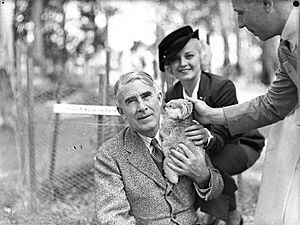
From 1923 to 1930, he spent a few weeks each year at his cabin in Central Arizona. This cabin was later restored and opened as a museum. Sadly, a fire destroyed it in 1990. It was later rebuilt 25 miles away in Payson.
During the 1930s, Zane Grey kept writing. But the Great Depression made it harder for publishers. His book sales went down. However, he had avoided investments affected by the stock market crash. He continued to earn money from his books, so he was better off than many. Almost half of the movies based on his novels were made in the 1930s.
From 1925 until his death in 1939, Zane Grey traveled more and further from his family. He became interested in exploring untouched places, especially islands in the South Pacific, New Zealand, and Australia. He felt Arizona was getting too crowded with tourists. Near the end of his life, Zane Grey wrote about the future:
The so-called civilization of man and his works shall perish from the earth, while the shifting sands, the red looming walls, the purple sage, and the towering monuments, the vast brooding range show no perceptible change.
His Love for Fishing
Zane Grey loved fishing. He helped start the "Porpoise Club" with his friend Robert H. Davis. They wanted to make fishing for dolphins and porpoises popular. They caught their first bottlenose dolphin off Seabright, New Jersey in 1912.
Zane Grey's son, Loren, said that his father fished about 300 days a year throughout his adult life. Zane and his brother R.C. often visited Long Key, Florida. They helped create the Long Key Fishing Club. Zane Grey was its president from 1917 to 1920. He was one of the first to fish for Boohoo fish (which are sailfish). A place called Zane Grey Creek was named after him.
Zane Grey also enjoyed fishing in Australia and New Zealand. He first visited New Zealand in 1926. There, he caught many large and different types of fish, including a mako shark. This shark was a fierce fighter and a new challenge for him. Zane set up a base at Otehei Bay in New Zealand. This place became popular for rich and famous people. He wrote many articles about how special New Zealand fishing was. He held many world records for catching large fish. He also invented the "teaser," a bait without a hook that is still used today to attract fish. Zane made three more fishing trips to New Zealand.
He also helped start deep-sea sport fishing in New South Wales, Australia, especially in Bermagui. This area is famous for marlin fishing. Zane Grey was a supporter of the Bermagui Sport Fishing Association in 1936 and 1937. He set several world records there and wrote about his experiences in his book An American Angler in Australia.
From 1928 on, Zane Grey often visited Tahiti. He fished in the waters around Tahiti for several months at a time. He even had a permanent fishing camp there. He said these were the hardest waters he had ever fished. But he also set some of his most important records there, like catching the first marlin over 1,000 pounds.
Zane Grey built a vacation home on Santa Catalina Island, California. This home later became the Zane Grey Pueblo Hotel. He was also the president of Catalina's special fishing club, the Tuna Club of Avalon.
His Death
Zane Grey passed away from heart failure on October 23, 1939. He died at his home in Altadena, California. He was buried in the Lackawaxen and Union Cemetery in Lackawaxen, Pennsylvania.
Zane Grey's Impact
His Books and Stories
Zane Grey became one of the first authors to earn a million dollars. His honest and exciting stories connected with millions of readers around the world. He inspired many Western writers who came after him.
Zane Grey played a big part in creating the popular ideas about the Old West. His books and stories were made into many films and TV shows. He wrote over 90 books. Some were published after he died. His total book sales are more than 40 million copies.
He wrote not only Westerns but also books about hunting, children's books, baseball books, and fishing books. Many of them became bestsellers. It's thought that he wrote over nine million words in his career. From 1917 to 1926, Zane Grey was on the top ten bestseller list nine times. This meant selling over 100,000 copies each time. Even after he died, his publisher kept releasing a new book of his every year until 1963. When his books were reprinted as paperbacks in the 1940s, his sales grew even more.
Erle Stanley Gardner, who wrote the Perry Mason mystery series, said that Zane Grey was great at connecting his characters to the land. He made the action in his stories feel real and important.
Zane Grey was even President Dwight D. Eisenhower's favorite writer.
Hollywood and Other Media
Zane Grey started working with Hollywood in 1916. That's when William Fox bought the rights to Riders of the Purple Sage. As Zane Grey's career grew, so did the movie industry. Movies quickly started adapting Western stories. Famous director John Ford began his career working on these films.
After his first two books became movies, Zane Grey started his own movie company. This allowed him to control how his books were made into films. After making seven films, he sold his company to Jesse Lasky, who was a partner at Paramount Pictures. Paramount made many movies based on Grey's writings and hired him as an advisor. Many of his films were shot in the real places he described in his books.
In 1936, Zane Grey appeared as himself in a film shot in Australia called White Death. He also provided a story that was filmed as Rangle River (1936).
Zane Grey became unhappy with how his stories were changed for movies. He felt his characters and plots were not as good when adapted. Nearly 50 of his novels were turned into over 100 Western movies. After Zane Grey's death, the success of the film Western Union (1941), based on one of his books, helped make Hollywood Westerns popular again.
Zane Grey's books The Lone Star Ranger and King of the Royal Mounted inspired two radio series. These were later adapted for television, becoming the famous shows The Lone Ranger and Challenge of the Yukon (later Sgt. Preston of the Yukon). More of Grey's work was shown on the Zane Grey Show on radio and the "Zane Grey Western Theatre" on TV.
Many famous actors started their careers in films based on Zane Grey's books. These included Gary Cooper, Randolph Scott, Shirley Temple, and Fay Wray. Directors like Victor Fleming (who directed Gone with the Wind) and Henry Hathaway (who directed True Grit) learned their skills on Zane Grey films.
Awards and Tributes
- The National Park Service takes care of his old home in Lackawaxen, Pennsylvania. It is now the Zane Grey Museum.
- Zanesville, Ohio, has a museum named after him, the National Road-Zane Grey Museum.
- A small street in Altadena, California, called Zane Grey Terrace, is named in his honor.
- There is a Zane Grey Tourist Park in Bermagui, Australia.
- A headland in New Zealand is called "Zane Greys'."
- The Zane Grey Continuation School is in Reseda, California.
- The Sigma Nu – Beta Rho house at the University of Pennsylvania has a Zane Grey room.
- Wilder Ranch State Park in California has a Zane Grey Trail.
- The Bureau of Land Management manages the Zane Grey Roadless Area (58,000 acres) along the Rogue River in Oregon.
- In 1977, he was added to the Hall of Great Westerners at the National Cowboy & Western Heritage Museum.
His Books
| Year | Title | Type of Story | Publisher | Notes |
|---|---|---|---|---|
| 1903 | Betty Zane | Historical | Charles Francis Press | Also called The Last Ranger in 1974 |
| 1906 | The Spirit of the Border | Historical | A. L. Burt Company | A follow-up to Betty Zane |
| 1908 | The Last of the Plainsmen | Western | Outing Publishing | Inspired by Charles "Buffalo" Jones |
| 1909 | The Last Trail | Historical | A. L. Burt Company | A follow-up to The Spirit of the Border |
| The Short Stop | Baseball | A. C. McClurg | ||
| 1910 | The Heritage of the Desert | Western | Harper & Brothers | |
| The Young Forester | Western | Harper & Brothers | ||
| 1911 | The Young Pitcher | Baseball | Harper & Brothers | |
| The Young Lion Hunter | Western | Harper & Brothers | ||
| 1912 | Riders of the Purple Sage | Western | Harper & Brothers | |
| Ken Ward in the Jungle | Western | Harper & Brothers | ||
| 1913 | Desert Gold | Western | Harper & Brothers | |
| 1914 | The Light of Western Stars | Western | Harper & Brothers | |
| 1915 | The Lone Star Ranger | Western | Harper & Brothers | |
| The Rainbow Trail | Western | Harper & Brothers | A follow-up to Riders of the Purple Sage | |
| 1916 | The Border Legion | Western | Harper & Brothers | |
| 1917 | Wildfire | Western | Harper & Brothers | |
| 1918 | The Roaring U.P. Trail | Western | Harper & Brothers | |
| 1919 | The Desert of Wheat | Western | Harper & Brothers | |
| Tales of Fishes | Fishing | Harper & Brothers | ||
| 1920 | The Man of the Forest | Western | Grosset & Dunlap | |
| The Redheaded Outfield and other Baseball Stories | Baseball | Harper & Brothers | ||
| 1921 | The Mysterious Rider | Western | Harper & Brothers | |
| To the Last Man | Western | Harper & Brothers | ||
| 1922 | The Day of the Beast | Fiction | Harper & Brothers | |
| Tales of Lonely Trails | Adventure | Harper & Brothers | ||
| 1923 | Wanderer of the Wasteland | Western | Harper & Brothers | |
| Tappan's Burro | Western | Harper & Brothers | ||
| 1924 | The Call of the Canyon | Western | Harper & Brothers | |
| Roping Lions in the Grand Canyon | Adventure | Harper & Brothers | ||
| Tales of Southern Rivers | Fishing | Harper & Brothers | ||
| 1925 | The Thundering Herd | Western | Harper & Brothers | |
| The Vanishing American | Western | Harper & Brothers | ||
| Tales of Fishing Virgin Seas | Fishing | Harper & Brothers | ||
| 1926 | Under the Tonto Rim | Western | Harper & Brothers | |
| Tales of the Angler's Eldorado, New Zealand | Fishing | Harper & Brothers | ||
| 1927 | Forlorn River | Western | Harper & Brothers | |
| Tales of Swordfish and Tuna | Fishing | Harper & Brothers | ||
| 1928 | Nevada | Western | Harper & Brothers | A follow-up to Forlorn River |
| Wild Horse Mesa | Western | Harper & Brothers | ||
| Don, the Story of a Lion Dog | Western | Harper & Brothers | ||
| Avalanche | Western | Harper & Brothers | ||
| Tales of Fresh Water Fishing | Fishing | Harper & Brothers | ||
| 1929 | Fighting Caravans | Western | Harper & Brothers | |
| Stairs of Sand | Western | Harper & Brothers | ||
| 1930 | The Wolf Tracker | Western | Harper & Brothers | |
| The Shepherd of Guadaloupe | Western | Harper & Brothers | ||
| 1931 | Sunset Pass | Western | Harper & Brothers | |
| Tales of Tahitian Waters | Fishing | Harper & Brothers | ||
| Book of Camps and Trails | Adventure | Harper & Brothers | Part of Tales of Lonely Trails reprinted | |
| 1932 | Arizona Ames | Western | Harper & Brothers | |
| Robbers' Roost | Western | Harper & Brothers | ||
| 1933 | The Drift Fence | Western | Harper & Brothers | |
| The Hash Knife Outfit | Western | Harper & Brothers | A follow-up to The Drift Fence | |
| 1934 | The Code of the West | Western | Harper & Brothers | |
| 1935 | Thunder Mountain | Western | Harper & Brothers | |
| The Trail Driver | Western | Whitman Publishing | ||
| 1936 | The Lost Wagon Train | Western | Harper & Brothers | |
| 1937 | West of the Pecos | Western | Whitman Publishing | |
| An American Angler in Australia | Fishing | Whitman Publishing | ||
| 1938 | Raiders of Spanish Peaks | Western | Whitman Publishing | |
| 1939 | Western Union | Western | Harper & Brothers | |
| Knights of the Range | Western | Harper & Brothers | ||
| 1940 | Thirty Thousand on the Hoof | Western | Harper & Brothers | |
| Twin Sombreros | Western | Harper & Brothers | A follow-up to Knights of the Range | |
| 1942 | Majesty's Rancho | Western | Harper & Brothers | A follow-up to Light of Western Stars |
| 1943 | Omnibus | Western | Harper & Brothers | |
| Stairs of Sand | Western | Harper & Brothers | A follow-up to Wanderer of the Wasteland | |
| 1944 | The Wilderness Trek | Western | Harper & Brothers | |
| 1946 | Shadow on the Trail | Western | Harper & Brothers | |
| 1947 | Valley of Wild Horses | Western | Harper & Brothers | |
| 1948 | Rogue River Feud | Fishing / Western | Harper & Brothers | |
| 1949 | The Deer Stalker | Western | Harper & Brothers | |
| 1950 | The Maverick Queen | Western | Harper & Brothers | |
| 1951 | The Dude Ranger | Western | Harper & Brothers | |
| 1952 | Captives of the Desert | Western | Harper & Brothers | |
| Adventures in Fishing | Fishing | Harper & Brothers | ||
| 1953 | Wyoming | Western | Harper & Brothers | |
| 1954 | Lost Pueblo | Western | Harper & Brothers | |
| 1955 | Black Mesa | Western | Harper & Brothers | |
| 1956 | Stranger from the Tonto | Western | Harper & Brothers | |
| 1957 | The Fugitive Trail | Western | Harper & Brothers | |
| 1958 | Arizona Clan | Western | Harper & Brothers | |
| 1959 | Horse Heaven Hill | Western | Harper & Brothers | |
| 1960 | The Ranger and Other Stories | Western | Harper & Row | |
| 1961 | Blue Feather and Other Stories | Western | Harper & Row | |
| 1963 | Boulder Dam | Historical | HarperCollins | |
| 1974 | The Adventures of Finspot | Fishing | D-J Books | |
| 1975 | Zane Grey's Greatest Indian Stories | Western | Dorchester Publishing | Includes original ending to The Vanishing American (1925) |
| 1977 | The Reef Girl | Fishing | Harper & Row | |
| 1978 | Tales from a Fisherman's Log | Fishing | Hodder & Stoughton | |
| 1979 | The Camp Robber and Other Stories | Western | Walter J. Black | |
| 1981 | The Lord of Lackawaxen Creek | Adventure | Lime Rock Press | |
| 1982 | Angler's Eldorado: Zane Grey in New Zealand | Fishing | Walter J. Black, Reed NZ | Part of 1926 edition reprinted (first 10 chapters, plus more) |
| 1982 | Lost in the Never Never | Australian Novella | Ian Henry Publishers | And "Silvermane" in same book |
| 1994 | George Washington, Frontiersman | Historical | University of Pennsylvania Press and Forge Books | |
| 1996 | Last of the Duanes | Western | Gunsmoke Westerns | Full version of The Lone Star Ranger (1915) |
| 2003 | The Desert Crucible | Western | Leisure Books | Full version of The Rainbow Trail (1915) |
| 2004 | Tonto Basin | Western | Leisure Books | Full version of To the Last Man (1921) |
| 2007 | Shower of Gold | Western | Leisure Books | Full version of Desert Gold (1915) |
| 2008 | The Great Trek | "Western" set in Australia | Five Star | Full version of The Wilderness Trek (1944) |
| 2009 | Tales of the Gladiator | Fishing | ZG Collections | Diary Entries from ZG on "Gladiator." 1920's, California fishing. |
| 2016 | Tales of Florida Fishes | Fishing | Zane Grey's West Society. | Collection of ZG Stories |
Movies Based on His Books
Between 1911 and 1996, 112 movies were made from Zane Grey's novels and stories. Also, three TV series had episodes based on his work, including Dick Powell's Zane Grey Theatre (1956–58).
|
|
Images for kids
See also
 In Spanish: Zane Grey para niños
In Spanish: Zane Grey para niños


